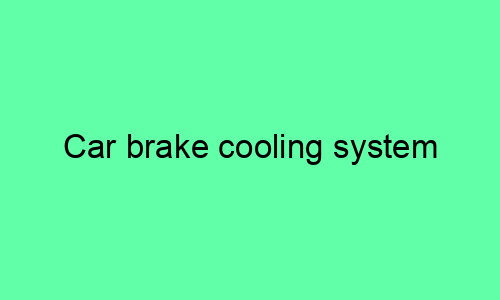Car Brake Cooling System
Introduction
The brake cooling system is an important part of a car’s braking system. It helps to dissipate the heat generated by the brakes when they are applied, which prevents them from overheating and failing.
How the Brake Cooling System Works
The brake cooling system is typically composed of a number of components, including:
* **Brake rotors:** The brake rotors are the large, metal discs that rotate with the wheels. When the brake pads are applied, they press against the rotors to slow the car down. This generates a lot of heat, which can cause the rotors to warp or crack if they are not cooled properly.
* **Brake calipers:** The brake calipers are the housing that hold the brake pads. They also contain pistons that push the brake pads against the rotors. The calipers are typically made of aluminum, which helps to dissipate heat.
* **Brake lines:** The brake lines carry brake fluid from the master cylinder to the brake calipers. The brake fluid helps to transfer the force from the brake pedal to the brake pads and calipers.
* **Brake fluid reservoir:** The brake fluid reservoir is a container that holds the brake fluid. It is typically located in the engine compartment.
When the brake pedal is applied, brake fluid is forced through the brake lines to the brake calipers. The pistons in the calipers then push the brake pads against the rotors, which slows the car down. The heat generated by the braking process is transferred to the rotors and calipers. The brake cooling system then helps to dissipate this heat, preventing the rotors and calipers from overheating.
Types of Brake Cooling Systems
There are two main types of brake cooling systems:
* **Passive brake cooling systems:** Passive brake cooling systems rely on natural convection and radiation to dissipate heat. These systems are typically used on cars that are not driven very hard.
* **Active brake cooling systems:** Active brake cooling systems use fans or other devices to force air over the brake rotors and calipers. These systems are typically used on cars that are driven hard or that have high-performance brakes.
Advantages and Disadvantages of Different Brake Cooling Systems
**Passive brake cooling systems** are less expensive and simpler to maintain than active brake cooling systems. However, they are not as effective at dissipating heat.
**Active brake cooling systems** are more effective at dissipating heat than passive brake cooling systems. However, they are more expensive and complex to maintain.
Choosing the Right Brake Cooling System
The type of brake cooling system that you choose will depend on your driving needs and budget. If you do not drive your car very hard, a passive brake cooling system may be sufficient. If you drive your car hard or have high-performance brakes, an active brake cooling system is a better choice.
Conclusion
The brake cooling system is an important part of a car’s braking system. It helps to dissipate the heat generated by the brakes when they are applied, which prevents them from overheating and failing. There are two main types of brake cooling systems: passive brake cooling systems and active brake cooling systems. The type of brake cooling system that you choose will depend on your driving needs and budget.






